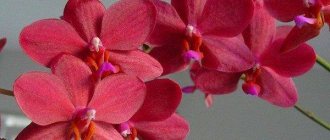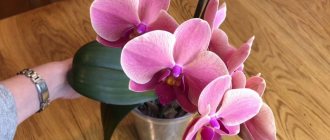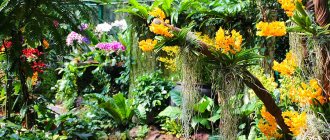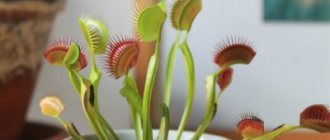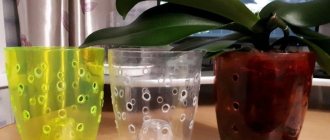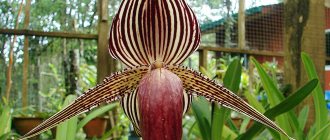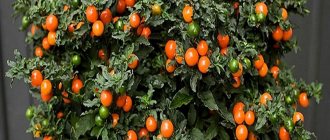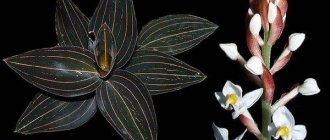Detailed description and photo
This type of orchid belongs to the hybrid varieties of Phelaenopsis . It got its name due to the unusual type of flowers, which in their shape resemble small parrots. Phelaenopsis Parrot has an attractive and showy flower that is round and regular in shape. It has wide, oval leaves that can reach a length of up to 30 cm.
This variety has long and stiff peduncles. The scientific name of this orchid variety is Phalaenopsis "Papagayo".
Distinctive characteristics
The official name of the species is Phalaenopsis Papagayo. It has abundant and long-lasting flowering. Phalaenopsis Parrot is a classic orchid species. Their distinctive features:
- The trunk is single, grows vertically, reaching a height of up to 30 cm.
- The leaves are oval, fleshy, bright green, up to 27 cm long. They are arranged in two rows.
- The root system is open (epiphytic), dense with a pearlescent tint. After irrigation it turns green. Well absorbs and retains moisture from watering and from the surrounding area.
- Peduncles are flexible, rigid, straight, racemose. Length – up to 60 cm. Diameter – 0.5 cm. Grows vertically. 1–3 pieces are formed on one plant. The surface is smooth and brown with a yellowish or greenish tint.
How is it different from other types?
The Parrot variety is a standard phelenopsis, although it has some distinctive features. First of all, this concerns coloring.
Unlike most types of orchids, this variety has bright flowers with an unusual color that have significant longevity. They are able to last more than one month and only turn slightly pale.
In addition, this plant, with proper care, is capable of growing several flower stalks at once, as a result of which the orchid stands completely covered with flowers.
The Parrot orchid does not have any varieties, but this variety can very often be found in the store under names such as :
- Phalaenopsis Breezes.
- Phalaenopsis Bee Sting.
- Phalaenopsis Elegant Charm Age.
- Phalaenopsis Chiada Francis Picotee.
All of the above names are synonyms.
Common errors
Trying to see a blooming orchid as quickly as possible, gardeners often make a grave mistake - they use cytokinin paste and other hormonal drugs.
Long-term drying helps to force the plant to bloom, during which watering is stopped for a month and the flower is kept in a cool place at a temperature of 18-19 ° C, after which it is transferred to warmer conditions, watered and fed with compounds where phosphorus is present in a higher proportion.
It is prohibited to use hormonal ointments for lateral buds during active flowering.
Bloom
The first flowering begins 4-5 months after planting. If you purchased a store-bought plant with bright flowers, the next flowering may occur in one and a half or two months, after the plant adapts to new conditions.
Flowering duration is about 6 months . The plant puts out new flower stalks, or grows buds on the tops of old ones.
Flowers form in families. As a rule, one flower consists of twenty inflorescences, the diameter of which is no more than 1 cm. The color of the flowers varies from burgundy to bright yellow. Color can also change under the influence of fertilizers used by the gardener. The flowers themselves are medium-sized and oval in shape. There are purple streaks along the edges, and small purple streaks along the veins.
Botanical description
- Leaves. Before the beginning of the flowering phase, up to 6-8 leaves are formed, located in both directions - horizontally and vertically half and half, as well as on both sides. The shape of the leaf blade is oval. The end is asymmetrically pointed. The surface is smooth. The structure is leathery. In the mature stage, length is 17-23 cm, width is 6-8 cm, thickness is up to 2 cm. The color is bright green.
- Root system. Formed by epiphytic thick roots with a pearlescent surface. When exposed to water they turn green. They absorb atmospheric and irrigation moisture, retaining it in the velamen layer.
- Peduncles. Flexible, tough. The shape is racemose. Quantity from 1 to 3 per plant. Length in mature state 40-60 cm, diameter 0.5 cm. Arranged vertically. The surface is smooth, without pubescence. The color is brownish with a yellow or green tint. The number of buds is 10-20.
- Inflorescences. The shape is classic, characteristic of phalaenopsis. The height of the flowers is up to 6 cm, the diameter is up to 7 cm, the depth of the tube is up to 1 cm. They are formed by wide, oval petals in the amount of 6 pieces, arranged in 2 tiers: the inner one consists of 3, the outer one - of 2 side petals. The color depends on the variety and composition of the fertilizers used. The main palette is contrasting, includes shades from bright yellow to light lemon, with almost white at the base. There is an ornament on the surface: reddish and purple spots, stripes and stains, located mainly at the edges and along the veins.
- Lip. It has a three-lobed structure. The color is purple-raspberry. There is a yellow tongue at the base.
- Kidneys. Oval shape. The color is yellow, sometimes with a purple tint. In a developed state, the height from the base to the end is 0.7-1.0 cm, the diameter at the midpoint of growth is 0.5-0.7 cm. They are distinguished by active spillage, creating favorable conditions for branching.
Landing
Choosing a pot
To ensure that the root system receives enough sunlight, it is best to plant in a transparent pot . A ventilation and drainage system should also be installed in this container. This is necessary to prevent water from accumulating in the roots. You can also use plastic containers.
What should the soil be like?
It is also necessary to select the appropriate substrate for the orchid. It must be air and water permeable, have a low concentration of nutrients and a slightly acidic reaction.
You can also make your own soil mixture for the plant. To do this, you will need to mix finely chopped fern roots, pine bark and loose, light leaf soil in equal proportions.
How to plant?
- The roots of the seedling should be placed in a container and distributed evenly.
- Fill all the free space between the roots with substrate.
- Compact the soil well.
- Place the plant in a cool, dark place for several weeks.
Features of correct landing
How to choose soil?
The development, growth and general condition of the orchid depend on proper planting with a well-selected substrate. Therefore, the main task of the grower is the correct selection of all components of the substrate.
Although hybrid phalaenopsis are unpretentious and sufficiently adapted for growing at home, they still conditions similar to natural ones . This especially applies to the selected soil composition.
It’s easier to purchase a ready-made substrate . In modern times, there is plenty of choice in flower centers and shops. If for some reason it is not possible to buy it, then it is not difficult to choose it yourself.
Important! You can experiment with the composition. The main thing is the correct selection of proportions of substrate components. An indicator of good soil is the development and full flowering of an orchid.
Orchid soil consists of several components.
The main components of the substrate are:
- Bark of coniferous (pine) or deciduous trees;
- Charcoal;
- Sphagnum moss;
- Inert materials - expanded clay, vermiculite, polystyrene, etc.
Capacity
The flower pot for phalaenopsis must be transparent to receive sufficient light, since the roots of the plant are no less involved in photosynthesis than the foliage. In addition, the container must contain holes for good drainage and air ventilation.
The ideal container is a transparent plastic pot, on which it is easy to make the required number of drainage holes.
Technology
Phalaenopsis transplantation is carried out only when there is an urgent need, with awareness of the matter for which it is being done.
Some inexperienced orchid growers begin replanting as soon as roots touch the walls of the flower pot. It is not right.
Phalaenopsis love crowded root systems and bloom more readily in such crowded conditions. Of course, you need to replant, but you need to change the substrate every 2-3 years, if there are no problems with the root system.
The technology of planting or replanting consists of carefully placing healthy roots in a container and filling the interroot and residual space with a correctly selected substrate.
Then the plant is shed a little and put in a shaded place for a couple of weeks for complete acclimatization at a temperature of no more than 24 ° C. Watering during this period is carried out once every 10 days.
Caring for a plant at home
Temperature
The optimal air temperature for this type of orchid is from 25 to 29 degrees during the day and from 18 to 22 degrees at night.
Lighting
Long daylight with diffused light is beneficial for an orchid . Avoid direct sunlight.
Watering
Watering should be done every three or four days, depending on climatic conditions.
There is no need to water the soil itself. The pot should be placed in a container of warm water for about 10-15 minutes.
Top dressing
You need to feed the orchid with fertilizers as needed. It is very important to maintain a balance here, since excess fertilizer can lead to a decrease in the orchid’s immunity.
Trimming
Pruning the Parrot orchid should be done only after it has completely bloomed . There are several ways to trim:
- First. Partially shorten the peduncle by cutting it 1.5 cm above the dormant bud.
- Second. Trim at the very base, leaving a small stump no more than 3 cm high.
Transfer
The plant should be replanted only after its root system has formed. It is also necessary to replant every 3 or 4 years. The main purpose of such a transplant is to replace the substrate, since over time it loses its beneficial properties.
Care during the flowering period
When an orchid blooms, it needs to be watered intensively. also recommended to spray the flower with a spray bottle about once a week and feed it with special fertilizers. This should be done after one watering.
What to do if it doesn't bloom?
There are many reasons that prevent an orchid from blooming. The cause may be excessive watering or too dry air. A solution of superphosphate in proportions of 20 grams per 10 liters of water will help to bring the beginning of flowering closer.
If the plant is too young, but has already sent out an arrow, then it should be broken off.
Main problems during the flowering period
Phalaenopsis blooms poorly if the surrounding microclimate does not meet its needs. The main thing for a flower:
- Regular inspection for fungi and pests. Appear due to improper care.
- Do not use drugs to stimulate growth and flowering.
- Correct temperature, humidity, lighting.
- Convenient container.
- Timely fertilizing, watering, pruning and replanting.
- Long daylight hours.
How does it reproduce?
Main methods of reproduction:
- By cuttings . Harvested from peduncles by cutting off a section with a dormant bud.
- By division . Combined with transplantation. You need to use a scalpel to cut off part of the plant, along with the roots and leaves. Then it should be dried, processed and planted in a separate container.
- Children . When children with aerial roots reach up to 3.5 cm, they are separated from the mother, treated with charcoal and planted in a separate container.
Suitable microclimate
The Parrot orchid variety needs to create conditions that are as close to natural as possible.
Temperature
Lack of light has a bad effect on flowering
The optimal temperature is 24-27°C during the day and 16-20°C at night. This difference activates the flowering phase.
Illumination
The home orchid requires diffused, but not direct, lighting with long daylight hours. Prolonged shading leads to inhibition of the flowering phase and shortens its duration.
In winter, you will need to use an artificial light source - a fluorescent lamp.
Humidity
The tropical plant develops well at a humidity of 70%. To maintain this level, the flower should be sprayed more often on the foliage and aerial roots with warm water.
Place
The best place for growing orchids at home will be the eastern or southwestern side.
Substrate
For phalaenopsis, soil mixtures of pine bark, charcoal and sphagnum, taken in a ratio of 5:1:2, are suitable. Peat and fern rhizomes are also added to them.
Requirement for potting container
For the Parrot variety, a transparent pot with a drainage system and ventilation is suitable, providing good penetration of light and air to the roots.
Prevention of various problems
The following can be done as preventative measures::
- Carefully inspect the seedlings before planting for damage and pests.
- Observe all conditions for caring for the plant.
- Treat the soil before planting with special means. You can use a solution of manganese and colloidal salt.
The Parrot Orchid, despite all its showiness and beauty, is a rather unpretentious plant. Proper care and compliance with all recommendations for growing orchids will help you grow a bright and healthy plant.
Feeding and watering the Parrot orchid
Proper watering is the key to orchid health and long flowering. Phalaenopsis Parrot, on the one hand, loves moisture, but on the other hand, it categorically does not tolerate waterlogging. The gardener's task is to find the boundary between drought and flood.
Common advice that recommends watering orchids once a week or every two weeks is devoid of practical meaning. When organizing irrigation of epiphytes, you need to take into account a lot of factors and the conditions of a particular apartment. Therefore, it is more correct to focus on the state of the plant itself:
- Inspect the roots. If they remain green, there is no need to water them.
- If the roots turn gray, inspect the pot. If condensation remains on the walls, you can refrain from watering.
- If the roots are gray and there is no condensation in the pot, the orchid can be watered.
If the parrot is not grown in a pot, but in a suspension with freely hanging roots, the need for watering is determined as follows: wait until the roots turn gray, then count 4-5 days and immerse the root system in water.
Parrots need feeding for lush flowering. But even here you need to maintain a balance and not “feed” the plant. Excess fertilizer leads to a decrease in the orchid’s immunity, and sometimes to intoxication, which can lead to death .
To feed Phalaenopsis Parrot, you can take one of the following mineral complexes:
| Name | Dilution rate |
| "Dr. Foley Orchid" | The fertilizer is completely ready for use and does not require dilution. It is applied by spraying leaves and free roots. |
| "REASIL for orchids" | 1 ml per 1 liter of water – for watering and spraying on the roots 1 ml per 2 liters of water – for spraying on the leaves |
| "Pokon for orchids" | 5 ml per 1 liter of water |
You need to feed the flowering phalaenopsis Parrot at the root through watering: once the plant is watered with clean water, the next time fertilizer is added to the irrigation water.
You can feed the leaves once a week in the summer. In the cold season, spraying is reduced, and foliar feeding is given no more than once every 2 weeks.
In the resting phase, Phalaenopsis Parrot does not need to be fertilized.
Tip #1. If the Parrot orchid has entered a dormant phase and does not bloom, it needs to be watered less often than a flowering one. In nature, phalaenopsis live in alternating seasons of drought and rain, so simulating such conditions can be useful.
Such common fertilizers as “Fasco”, “Agrecol”, “Bona Forte”, etc. are also suitable for feeding the Parrot orchid. The main thing is to choose specialized formulations intended strictly for orchids.

